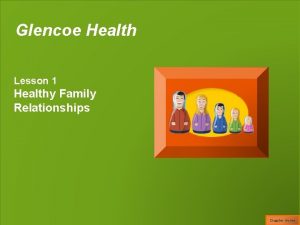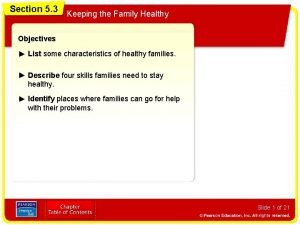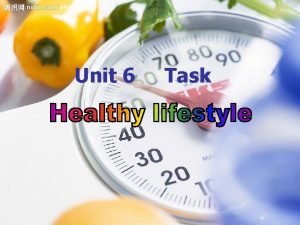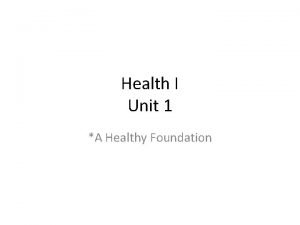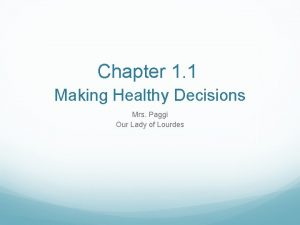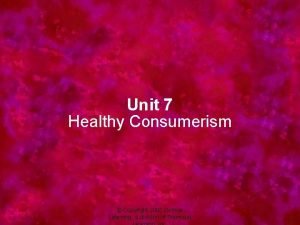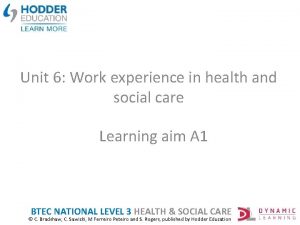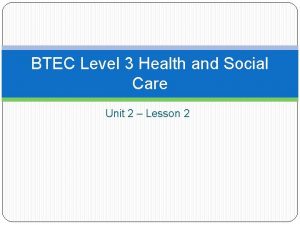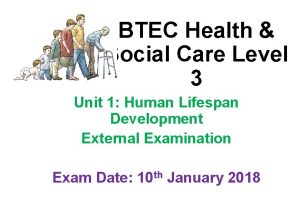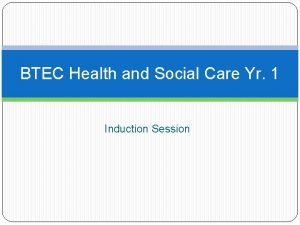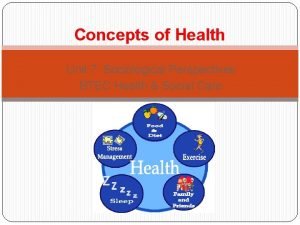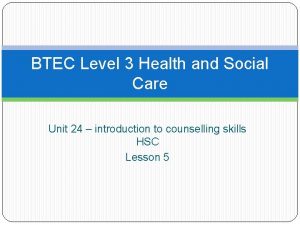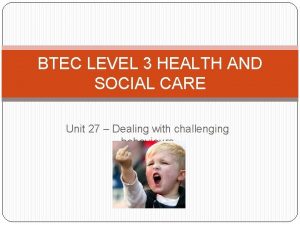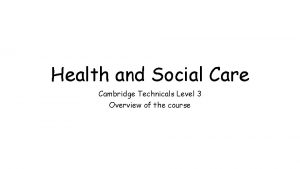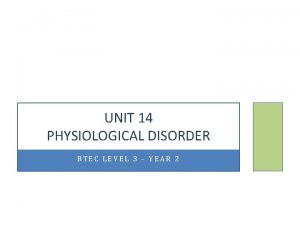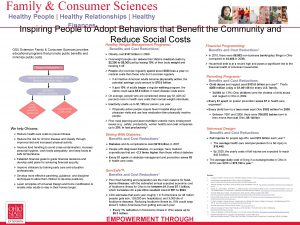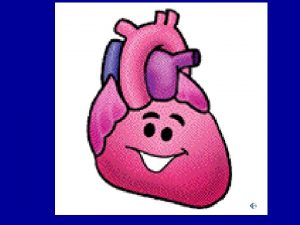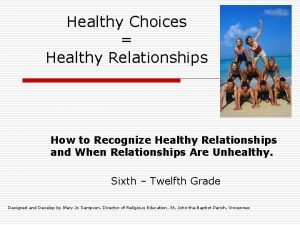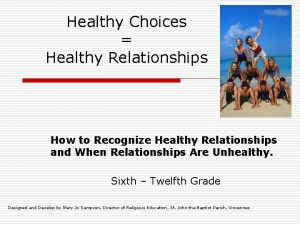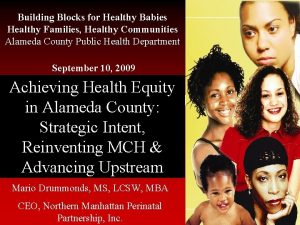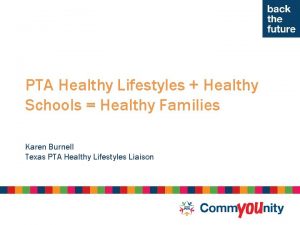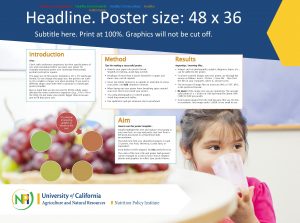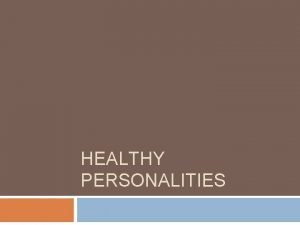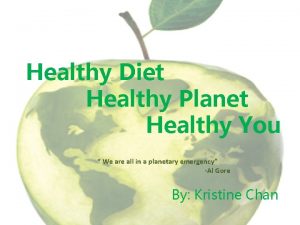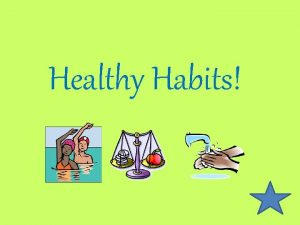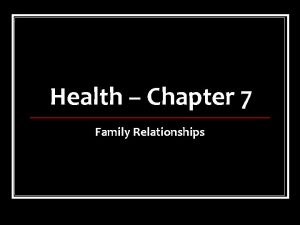UNIT 7 FAMILY SOCIAL HEALTH Health Education Healthy



















































- Slides: 51

UNIT 7 - FAMILY & SOCIAL HEALTH Health Education

Healthy Relationships • Relationship: A bond or connection you have with other people. • Friendship: A significant relationship between two people that is based on caring, trust, and consideration. • Citizenship: The way you conduct yourself as a member of the community. What’s Your Opinion? • How did your parents or grandparents meet? • Do you think you will marry someone like your mother/father? Why?

Preventing Fights • Common Causes of Conflict: – Power Struggles, Loyalty, Jealousy/Envy, Property Disputes, Territory & Space • Once you recognize a conflict you have 2 options: – 1) Ignore the conflict – 2) Confront the person • Ignoring Conflict – Be Flexible – Learn to control your anger • Confronting a person wisely – Choose the time and place carefully – Stay calm – Negotiate a solution (use “I messages”) • Do the unexpected – be friendly, kind and caring • Provide a way out – give a solution other than fight (lets try this for a week) • Be willing to apologize • Help Others Avoid Fights – Mediation: The process for resolving conflicts that involves a neutral third party.

Effective Communication • Express feelings openly • Use “I Statements”, rather than “YOU statements” – Example: I feel upset when this happens vs. you always do this to me. • • Let partner finish statements of feeling without interrupting Express empathy (I understand how you feel) Suggest alternatives to solve problem Use fair “above the belt” statements rather than “below the belt” comments that have nothing to do with the arguments (since they are usually insults) • Humor positively can work (use laughter vs. humor used negatively)

INFATUATION “CRUSH” First feelings of intense attraction to another person, passion, and being “in love”. • Physical Symptoms: – Blushing – Sweating – Clumsiness – Butterflies – Increased Perspiration – Verbal / Physical Awkwardness • Emotional Symptoms: – Giddy – Can’t Sleep – Nervousness – Decrease appetite • (1/3 will increase) – Euphoric • The brain will release high levels of: Dopamine & Nor epinephrine: Will give person a “high”.

Marriage • Approximately 90% of all Americans marry at some point during their lives. – It is one of the most important decisions you can make (affecting you, your spouse, family, friends, and future generations). • Successful marriages are based on “Real Love”. – Many young people mistake sexual attraction and short-lived crushes for love. – “Real Love” is long lasting and demonstrates: • LOVE: when you love someone, his or her well-being becomes as important to you as your own. • Commitment: strong determination by the couple to make their marriage a fulfilling lifelong relationship, despite the challenges • Compatibly: The ability to live together in harmony • Communication • Mutual Respect • Physical Attraction • Ability to compromise

MOST IMPORTANT COMPONENTS IN THEIR RELATIONSHIP According to 1000 married couples surveyed • #1 Communication • #2 Trust • #3 Respect • #4 Love • #5 Responsibility • #6 Commitment / Loyalty • #7 Patience • #8 Sense of Humor • #9 Compassion / Understanding • #10 Sex

WARNING SIGNS OF AN ABUSIVE RELATIONSHIP • Blames you for his/her problems • Tries to control your behavior • Criticizes you frequently- your appearance, intelligence, ability to make decisions • Humiliates you in public • Feels he/she owns you and has certain rights over you • Threatens you; makes you afraid of him/her • Isolates you (from friends/family) • Jealous of your friends/family- (unfaithful when around opposite sex) • Angers easily

How to End a Relationship • Write down your thoughts & feelings – Make a list of reasons why you don’t want to continue in the relationship. Putting your thoughts on paper can also help you confirm your decision after the fact. • Practice telling the person that you want to break up – Practice saying it out loud with a friend or family member. It can help you be less nervous & might give you insights from another person’s perspective. • Be honest & straightforward, but kind. – Avoid anger & resentment. Express feelings openly but without resorting to name calling or yelling. – Make sure you are in a safe & public place if you have any reason to think he or she may become extremely upset. • Have someone to talk to afterward – After breaking up, you may experience doubts & regrets about your decision – it is normal – it doesn’t mean you made the wrong decision. Make sure you have someone who can listen to your feelings & will support you. • Make a list of what you learned from this relationship to take into the next relationship you have. – Every relationship can be an opportunity to learn something new.

Abstinence • “To Abstain”: means to voluntarily choose not to do something. – When referring to sex. It means voluntarily choosing not to engage in sexual activity until marriage. • Sexual activity refers to any type of genital contact or sexual stimulation including, but not limited to, sexual intercourse. • Abstinence is the only 100% effective protection from possible physical, emotional, mental and social consequences of sex before marriage. – Abstinence is the safest & healthiest lifestyle. • Did You Know? – Rates of teen sexual activity have been steadily declining for over a decade. – The majority of high school students have never had sexual intercourse and are not currently sexually activity. – Many teens are choosing to save sex until marriage, which is often referred to as “abstinence”. • What are the benefits of being abstinent? (physical, mental and social)

Why Abstinence • Sex is good…. in Context – Context helps us understand that activities which are appropriate in certain situations are inappropriate in others. – Examples: • Jeans are great, but not if you are invited to the White House • Joking around & laughing out loud is normal & fun, but what if you are at a funeral? • There’s nothing wrong with driving a car 220 miles per hour – if you’re in the Daytona 500. But what is someone is driving 220 mph through your neighborhood where little kids are riding their bikes & crossing the streets? – Abstinence is simply about keeping sex in its proper context. It’s not about having sex – it’s about saving sex for a marriage relationship which is the safest and healthiest context. People don’t choose abstinence because sex is bad, but because it is good. – Abstinence is about saving, protecting, and preserving sexual activity for the context of marriage.

Why Abstinence • Choosing Abstinence may mean breaking free from past decisions and patterns. Abstinence is about making choices and decisions for your future, regardless of your past. – Even if a person has been sexually active in the past, it’s never too late to start over again and to choose to save sex for marriage. – Abstinence is about having the freedom to live your life the way you want to live it, by protecting yourself from the possible negative consequences of sexual activity. • Most teens surveyed who have been sexually active say that they wish they had waited? Why do you suppose this is? ?

Why Abstinence • Something to think about: – Most unintended pregnancies (53%) occurred among women who were using birth control. – 88% of teens surveyed say that they are determined not to get pregnant or get someone pregnant as a teen. – 1 in 5 sexually active teen girls become pregnant. – The United States has the highest rates of STDs in the industrialized world. – Most teens who are sexually active have never been tested for STDs. – Most people who are infected with an STD don’t even know it. What are the negative consequences of being sexually active during the teenage years? (physical, mental and social reasons)

Sex & the Media • Each year, Americans consume greater amounts of media than in the previous year. As a result of media’s growth & influence, we become very familiar with the media world and less familiar with the real world in which we live. • Which of the following statements would you say most closely reflects the media’s typical portrayal of sexual activity? • Sexual activity is okay for anyone at anytime. • Sexual activity should be reserved for a marriage relationship. o We are exposed to approximately 6 hours of media messages per day. • • To what extent do you think that the media influences you? (none – some – a lot? ) Did you know? – American teens watch an average of 28. 3 hours of TV per week or 4 hours per night. – The average child in America will spend more time watching TV by the age of 5 than talking to his or her father in an entire lifetime. – The average American will spend 10 uninterrupted years watching television over the course of his or her life.

Reproduction Unit 7

THE ENDOCRINE SYSTEM • Endocrine System: regulates long-term changes in the body such as growth and development. It also controls many of your body’s daily activities. – The Endocrine System includes: the Hypothalamus, Pituitary gland, Thyroid gland, Parathyroid gland, Thymus glad, Adrenal glands, Pancreas, and Reproductive glands. • Hormones: chemical messages in the bloodstream that travels to target cells in the body to speed up, slow down, turn on or turn off cell activities of the body. • Puberty: the period of sexual development during which a person becomes sexually mature and physically able to reproduce. – Average Boys: age 12 -14: Stops at 20 – Average Girls: age 10 -12: Stops at 18

The Endocrine System Ovaries The female reproductive glands release sex hormones that regulate egg maturation and control changes in a female’s body at puberty. Testes The male reproductive glands release a sex hormone that regulates sperm production and control changes in a male’s body at puberty.


The Female Reproductive System

THE FEMALE REPRODUCTIVE SYSTEM • The functions of the Female Reproductive are: • To produce sex hormones • To produce eggs • To provide a nourishing environment in which a fertilized egg can develop into a baby

Endometrium Endometrial Lining

Vulva Perineum Bartholin Glans

FEMALE ANATOMY STRUCTURE & FUNCTION • Vagina – A muscular passage leading from the uterus to the outside of the body. • Sperm enters a woman’s body through the vagina. – Birth Canal (last pathway for baby). • The walls of the vagina are very elastic, which allows it to expand dramatically during childbirth. • Surrounded by Vulva & Hymen Cover Vulva – Collective term for external genitalia

FEMALE ANATOMY STRUCTURE & FUNCTION CONTINUED… • Vulva: A collective term for external genitals (seen from outside view) – Clitoris (kli-to-ris): small, highly sensitive sexual organ found in front of vaginal opening. • Mons Pubis: the fatty pad of tissue under the pubic bone. • Labia Majora: “outer lips” rounded pads of tissue that lie around both sides of vaginal opening. • Labia Minora: “inner lips” folds of skin lying on either side of the vaginal opening.

VULVA STRUCTURE CONT… • Bartholin Glands: Glands that lie inside the inner lips. They secrete lubrication for females. Can also be a site for cysts (where glans become infected). • Perineum: Skin between the vaginal entrance and the anus. This is also the area an “episiotomy” is performed if a female needs one during delivery. 80%-90% of 1 st births have this done. • Hymen: A thin sheet of tissue with one or more holes in it called the hymen partially covers the opening of the vagina. Hymens are often different from person to person. Most women find their hymens have stretched or torn after their first sexual experience, and the hymen may bleed a little (this usually causes little, if any, pain). Some women who have had sex don't have much of a change in their hymens, though. • Prepuce: Hood of the clitoris. is a fold of skin that surrounds and protects the clitoral glans. It develops as part of the labia minora.

FEMALE ANATOMY STRUCTURE & FUNCTION CONTINUED… Cervix • Glans around cervix produce cervical mucous which increases during ovulation • Lower opening of Uterus • Pap Smear – Tests for cervical cancer (not for STDs) • Dilates at Birth – 10 cm

FEMALE ANATOMY STRUCTURE & FUNCTION CONTINUED… • Uterus – Strong elastic muscle “pouch” or “womb”. – The uterus is about the size of your fist & shaped like an upsidedown pear, with a thick lining and muscular walls. – The uterus contains some of the strongest muscles in the female body. These muscles are able to expand contract to accommodate a growing fetus and then help push the baby out during labor. • Endometrium: (Endometrial Lining) Inner Lining/membrane of the Uterus. A nutrient rich layer of blood & tissue to support a fertilized egg.

UTERUS CONT… • Contractions: The muscles of the uterus can contract for up to 60 seconds long. Contractions may begin a few weeks before labor and can regularly occur for several hours before delivery • “Prolapse of Uterus”: Can occur because of pregnancy, childbirth, or aging – Uterus detaches and moves out of place. Surgery can correct it.

Fallopian Tubes • • • Two tubes/passageways that carry eggs (ovum) away from the ovaries. Tiny hairs (cilia) and muscular contractions move ovum along towards the uterus. For conception to occur egg must be fertilized within 24 hours. Fallopian Tubes are the site of conception. Egg travels one inch per day. Tubal Ligation or “tube tied” • Ectopic Pregnancy: occurs when a fertilized egg, or zygote, doesn't travel into the uterus, but instead grows rapidly in the fallopian tube. • Girls with this condition can develop severe abdominal pain and should see a doctor because surgery may be necessary.

Ovaries • Ovaries are the primary reproductive glands. They produce eggs (Ova/Ovum) and sex hormones (Estrogen) – Located a few inches below the waist, one on each side of the body (about the size of an almond). – Born with about 400, 000 immature eggs, but only 500 will ever develop into mature eggs. • Also a common site of cysts: functional, dermoid, endometrioma

OVARIES CONT… • Release Estrogen which: – – – Fat deposits on breasts Widen pelvis (for childbirth) Smooth soft skin Fat on butt and thighs (cushion for childhood) Slows growth (that is why women are generally smaller than most men) Pubic hair (strong and course to protect vaginal opening) • Release Progesterone which: – Prepares the body for pregnancy – Maintains growth and health of uterine lining • Females also have Testosterone in small amounts

Menstruation • Menstruation: is the shedding of the lining of the Uterus (Endometrium) accompanied by bleeding. – Average Menstruation: 5 days & about 2 -8 oz. – Average Cycle is 28 days. (can vary 24 -35 days). • • Menarche: 1 st Period (age 11 -14) Menopause: End of Period (age 42 -51) • Missing Periods result when: • Ovulation: once puberty begins, one of the ovaries releases a ripened egg about once a month. The tiny egg that is released is no larger than the period at the end of this sentence. • Menstrual Cramps: are caused by contractions of the uterus. Women with severe cramps should see a doctor about possible treatment. – Common Symptoms include: Hot flashes, osteoporosis – – Pregnant High Stress Start Menstruation (the menstrual cycle can be irregular during puberty) Eating Disorders (extreme weight loss or gain cause irregularities)

Menstruation – Endometrial Lining Shed - Breast tissue Tender - PMS (bloating & cramps) 1 st day of flow (last months lining. FSH Release: tells ovaries to start growing an egg. If Egg is not fertilized, hormone levels fall and egg begins to disintegrate 1. New Eggs Develops 2. Endometrial Lining Rebuilds Lining gets more thick & rich. Inlets also develop for egg to attach. OVULATION (-14 days from end of cycle) (egg arrives day 13 & dies on day 15) Days 6 -11 Breasts enlarge in preparation for potential pregnancy

PROBLEMS OF THE FEMALE REPRODUCTIVE SYSTEM Vaginitis: Infection when Ph becomes disrupted. (wet clothing, antibiotics, nylon underwear, or can also be transmitted sexually). Douching can worsen symptoms. • Caused by yeast, bacteria, or other microorganisms. • Symptoms: thick discharge, odors, vaginal itching, and a burning sensation during urination. • Only doctors can diagnose the specific cause of vaginitis and provide appropriate treatment. PID – Pelvic Inflammatory Disease: Infection that can scar reproductive organs. Most commonly associated with untreated STD’s. 1 million diagnosed with each year. TSS – Toxic Shock Syndrome: Bacteria can breed on the blood that is left on tampons within the body. Flu-like symptoms. Severe cases = death.

PROBLEMS OF THE FEMALE REPRODUCTIVE SYSTEM • Endometriosis: (1 out of 10 women) Fragments of the uterine/endometrial lining implants elsewhere in the body, where they bleed similar to menstruation, only the blood is absorbed by the body. – Can be treated with hormones (sometimes birth control pills). If left untreated, can lead to infertility. • UTI – Urinary Tract Infections: Usually bacteria (from anus or elsewhere) gets into urethral opening.

Other important terms related to the Female Reproductive System • Gynecologist: Doctor who specializes in disorders of the woman’s reproductive organs. • Hysterectomy: Operation done to remove the uterus (womb). No longer can have children, no menstruation.

The Male Reproductive System

PRIMARY FUNCTIONS OF THE MALE REPRODUCTIVE SYSTEM 1. Produce Sperm 2. Produce sex hormone: testosterone


Male Reproductive System Penis – 3 cylinders of erectile tissue, not a muscle (can’t work it out, no bones) – Skin on shaft is hairless and wrinkled to allow for expansion during erection. – Very Sensitive – Tip most sensitive • Glans: rounded & sensitive head of the penis • Foreskin: circular fold of skin that covers the glans of an uncircumcised penis • Circumcision: (religious, cultural) The removal of the loose skin (foreskin) covering the head/tip of the Penis. • Urethra: a tube that passes through the penis to the outside of the body. Carries both urine (from the bladder) and sperm out of the body.

Male Reproductive System Continued…. • Erections: Needed to get blood to tissue. Triggered sexual thought, sight or touch. Especially common during puberty. – Nocturnal Emissions (“wet dreams”), – Erections are usually the 1 st indicator of sexual arousal (not but always) • Ejaculation: The ejection of semen from the erect penis. Muscles in the reproductive system & at the base of bladder contract – forcing semen through the urethra. – 1 st occurs for boys 13 -14 years – 100 -600 million sperm leave the body during each ejaculation (10 million or less is considered “sterile”) • Ejaculatory Duct: Opens during arousal, closes on urethra so one cannot urinate inside a female.

Male Reproductive System Continued…. Scrotum • Loose pouch of skin that hang outside the body and hold the testes – Regulates temperature of testes (best maintained at 8993º F to keep sperm healthy) (lower than internal body temperature) • Cremasteric Muscles: Group of muscle fibers in internal oblique. Contract to bring testes up closer to the body (warm up) or relax to lower testes away from the body (cool down).

Male Reproductive System Continued…. Testes • 2 found in the scrotum sac (oval shaped, usually about 4 cm long & 2. 5 cm wide ) • Contain seminiferous tubules • Millions of sperm are produced each day! • Takes 60 days for sperm to fully form Sperm • Could live in the vagina for 3 days (average) • “Super Sperm” can live up to 7 days (great chance of pregnancy) • Sperm can live outside the body 10 -20 minutes

PENIS FACTS • Actual amount of semen per ejaculation: 1 -2 teaspoons • Average number of times a man will ejaculate in his lifetime: 7, 200 • Average total amount of lifetime ejaculate: 14 gallons (it takes 35 gallons of water to fill a tub) • Average speed of ejaculation: 28 MPH (an average city bus goes about 35 MPH) • Largest penis in the animal kingdom: Blue whale at 11 feet (height from the floor to the rim of a basketball hoop is 10 feet) • Odors that increase blood flow to penis: lavender, licorice, chocolate, doughnuts, and pumpkin pie

Testes 2 Major Functions 1) Produce Sperm 2) Produce Sex Hormone: Testosterone – Male teens produce 6 x as much as older men, levels are highest 1 st thing in the morning and in the fall – 6 Characteristics: • • • Longer heavier bones Larger muscles Thicker skins Deeper Voice Body Hair Increased BMR

Male Reproductive System Continued…. • Epididymis – If uncoiled would be 6 meters long – 20 feet – Actually 3. 8 cm. With coils in tact – Sperm mature – Stores sperm 1 -10 days • Vas Deferens – Also sperm storage (moves back and forth by cilia when not aroused – Transports sperm from the testes, out of the scrotum, to urethra – Precedes Ejaculation = Semen • Vasectomy: Male sterilization in which the sperm duct is cut and tied off. • When the vasectomy is complete, sperm can no longer exit the body through the penis. They are broken down and absorbed by the body

Male Reproductive System Continued…. • Cowper’s Gland (Bulbourethral Gland): lubricates urethra and produces alkaline fluid to lower acidity. Many contain sperm (pre -ejaculation) • Prostate Gland: Heart shaped. Neutralizes acidity of the urethra/vagina. Adds chemical substance (30% of semen) • Seminal Vesicle (seminal fluid) – 2 sac-like structures that lie above the prostate. Feeds sperm with sugary fluid. Account for about 60% of semen • Semen: The mixture of sperm cells and fluids. The Alkaline fluid acts as a buffer, helps sperm swim, contains prostaglandins which cause the uterus and cervix to contract to allow sperm to go through.

Sperm Production (step by step) 1. 2. 3. 4. Produced in the Testicles Mature in Epididymis Travel thru the Vas Deferens Pick up fluids from Seminal Vesicle (70% of semen) 5. Pick up fluids from Prostate (30% of semen) 6. Pick up fluids from Cowper’s Gland 7. Leave the body thru the Urethra (ejaculation)

Problems of the Male Reproductive System • Testicular Cancer: (ages 15 -34) Hard lumps, enlarged testes. • Prostate Cancer: most common type of cancer among men. • Sterility: If ejaculation is less than 150 million a man is classified as sterile – Causes: illness, injury, mumps, exposure to Xrays, nuclear radiation can decrease sperm count, drug use. • Impotence or “erectile dysfunction”: can’t obtain an erection. Effects 1: 5 men (90% organic, 10% psychological) • Premature Ejaculation: also known as rapid ejaculation, premature climax, early ejaculation

4 stages of Sexual response • #1 Excitement – Males – 1 st sign is erection – Females – lubrication in vagina – Both may have swelling in nipple area as well as female overall breast tissue swelling. • #2 Plateau – Male – completely erect – Females – swelling or thickening of the tissues surrounding the vagina

4 stages of Sexual response • #3 Orgasm – Males – rhythmic contraction of the pelvic organs and semen is forced out – Females – muscular contraction that has movements from uterus down to cervix (clitoral orgasm, vaginal orgasm) • #4 Resolution – Body returns physiologically to unaroused state – Men enter into a refractory period during which they are incapable of becoming aroused (this may last anywhere from minutes to 24 hours)
 Journal on healthy food healthy mind
Journal on healthy food healthy mind Healthy soil healthy life poster ideas
Healthy soil healthy life poster ideas Healthy forests healthy communities poster contest
Healthy forests healthy communities poster contest Healthy nurse healthy nation
Healthy nurse healthy nation Hfle curriculum trinidad secondary
Hfle curriculum trinidad secondary Chapter 7 family relationships
Chapter 7 family relationships Chapter 7 lesson 1 healthy family relationships answer key
Chapter 7 lesson 1 healthy family relationships answer key Chapter 5 family relationships answers
Chapter 5 family relationships answers Define the relationship chapter 14
Define the relationship chapter 14 Lesson 3 keeping the family healthy
Lesson 3 keeping the family healthy Strong relationships
Strong relationships Difference between health education and promotion
Difference between health education and promotion Health education defintion
Health education defintion Apa itu social thinking
Apa itu social thinking Social thinking social influence social relations
Social thinking social influence social relations Unit 10, unit 10 review tests, unit 10 general test
Unit 10, unit 10 review tests, unit 10 general test Unit 6 how we keep healthy
Unit 6 how we keep healthy Stay healthy unit 3
Stay healthy unit 3 Youtuoi
Youtuoi Unit 1 health
Unit 1 health Making healthy decisions unit test
Making healthy decisions unit test Unit 3 a healthy life
Unit 3 a healthy life Unit 2 healthy habits
Unit 2 healthy habits Unit 2 healthy habits
Unit 2 healthy habits Unit 7 healthy and wise
Unit 7 healthy and wise Health propaganda definition
Health propaganda definition Health and social care level 3 unit 6
Health and social care level 3 unit 6 Unit 2 health and social care
Unit 2 health and social care Unit 2 health and social care level 3 past papers
Unit 2 health and social care level 3 past papers Physiological disorders and their care
Physiological disorders and their care Health and social care unit 5 coursework example p3
Health and social care unit 5 coursework example p3 Health and social care level 3 unit 2
Health and social care level 3 unit 2 Unit 12 health and social care level 3
Unit 12 health and social care level 3 Unit 5 health and social care assignment
Unit 5 health and social care assignment Unit 27 health and social care
Unit 27 health and social care Unit 14 learning aim d
Unit 14 learning aim d Unit 10 sociological perspectives
Unit 10 sociological perspectives Unit 24 health and social care
Unit 24 health and social care Btec level 3 health and social care unit 4
Btec level 3 health and social care unit 4 Health and social care unit 2
Health and social care unit 2 Ocr cambridge technicals health and social care
Ocr cambridge technicals health and social care Unit 40 health and social care
Unit 40 health and social care Unit 14 assignment 2 health and social care
Unit 14 assignment 2 health and social care Health and social component 3
Health and social component 3 Conclusion on topic family
Conclusion on topic family Periodic table staircase
Periodic table staircase Binuclear family vs blended family
Binuclear family vs blended family Ferpa violation
Ferpa violation Fefe curriculum
Fefe curriculum Version 9
Version 9 Montana family education savings program
Montana family education savings program Fefe curriculum
Fefe curriculum





